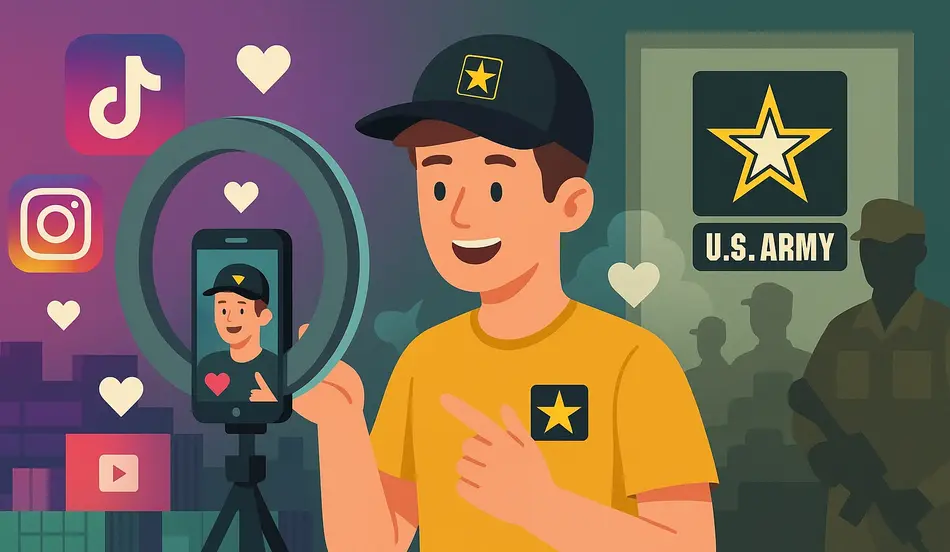Military jobs for Gen Z social media is the new reality of recruitment in 2025. What once relied on Uncle Sam posters in the 1940s and high-energy TV ads in the 1980s has now shifted to TikTok, Instagram, and YouTube platforms where Gen Z spends most of their time.
Facing enlistment shortfalls, the U.S. Army has turned to social media influencers from fitness creators and gamers to lifestyle vloggers who showcase military life as a modern, attractive career option for Gen Z. These campaigns highlight stability, skills, and community, reframing military jobs as more than drills and deployments.
Early data suggests the strategy is working. The Army has already exceeded its 2025 recruitment targets, thanks in part to influencers presenting military jobs in a way that resonates with Gen Z’s social media lifestyle and digital-first mindset. But critics warn that glamorizing service through influencer campaigns may mask the realities of military life.
The bigger question: is this new wave of military
jobs for Gen Z
social media recruitment a sustainable model, or just a flashy band-aid?
The Recruitment Problem
Why the Army Needed Change
For years, the U.S. military faced a troubling trend: enlistment shortfalls. In 2022 and 2023, the Army missed recruitment targets by as much as 25%, citing fewer young Americans meeting physical, educational, and legal eligibility requirements.
Gen Z, defined broadly as those born between 1997 and 2012, presented unique hurdles:
- Skepticism of authority: Many are wary of government institutions.
- Economic alternatives: Opportunities in tech, trades, and remote work compete with military service.
- Cultural divides: Social media exposure to global conflicts has made some reluctant to serve.
Traditional recruiting—career fairs, commercials, and school visits—was failing to resonate. The Army needed to speak the language of Gen Z: authenticity, digital storytelling, and influencers they already trust.

The Influencer Strategy
Who They Partner With
The Army’s influencer partnerships span niches:
- Fitness influencers emphasize discipline, strength, and adventure.
- Gamers and streamers highlight Army technology and e-sports competitions.
- Lifestyle vloggers share “day in the life” stories of Army personnel, from morning routines to international travel.
- Adventure creators showcase training exercises, parachute jumps, and camaraderie.
These influencers aren’t necessarily soldiers themselves. Instead, they are storytellers hired to frame Army life as relatable—using their platforms to normalize enlistment as a viable career path.
The Message
The Army’s narrative has shifted from purely patriotic duty to personal benefit:
- “A stable paycheck.”
- “Career training for the future.”
- “Community and belonging.”
- “Adventure and travel opportunities.”
In short, the influencer campaigns emphasize stability + purpose, two values Gen Z ranks highly in surveys about career decisions.
What Gen Z Wants
Stability in an Uncertain Economy
Gen Z has grown up through economic recessions, a pandemic, and rising housing costs. For many, the Army’s promise of job security, healthcare, and benefits is appealing compared to the instability of gig work or corporate layoffs.
Purpose and Community
Surveys show that Gen Z values work that aligns with personal meaning. Influencer campaigns stress camaraderie, teamwork, and service—positioning the Army as not just a job, but a mission.
Skill Building
From cybersecurity to medical training, the Army offers technical and transferable skills. Influencers highlight these pathways, reframing service as a launchpad for civilian careers.
Connect With the Next Generation of Talent
Post your job on WhatJobs and attract Gen Z candidates seeking stability, purpose, and skill-building opportunities in today’s uncertain economy.
Post a Job Now →Early Results: Recruitment Targets Met
The Army reports that enlistment goals for 2025 were met months ahead of schedule—a turnaround from previous years of shortfalls. Officials credit the influencer campaign as a major factor, noting that interest surged on social platforms where Gen Z spends most of its time.
For the first time in years, recruiters aren’t just chasing applicants—they’re fielding inbound interest from teens and young adults exposed to engaging, relatable content online.
Criticism and Controversy
Not everyone is celebrating.
Accusations of Propaganda
Civil liberties advocates argue that using influencers to recruit glamorizes military service without fully addressing its risks. Unlike commercials, influencer content blurs the line between advertising and authentic storytelling, potentially misleading audiences.
Ethics of Targeting Young Audiences
Critics worry that campaigns on TikTok and Instagram target users as young as 16, who may lack the maturity to make life-altering career decisions.
Selective Storytelling
Influencer content highlights travel, training, and teamwork but rarely addresses the challenges of deployment, combat stress, or reintegration after service. Some veterans call it “sanitized storytelling.”
The Bigger Picture: Influencer Recruitment Across Industries
The Army may be leading the charge, but it’s not alone. Corporations, universities, and even trade schools are experimenting with influencer-led recruitment.
- Tech companies use influencers to showcase diversity in STEM careers.
- Healthcare systems partner with nurses on Instagram and TikTok to highlight hospital work.
- Skilled trades use YouTubers to promote apprenticeship pathways.
The underlying lesson: authentic, peer-driven voices carry more weight with Gen Z than institutional marketing.
FAQ: Understanding Army Influencer Recruitment
Q1: Why is the Army using influencers now?
Because traditional recruitment methods weren’t connecting with Gen Z. Influencers bridge that gap by offering authentic, relatable storytelling.
Q2: Are these influencers soldiers themselves?
Not always. Many are civilian creators contracted to highlight aspects of Army life in a positive light.
Q3: What kind of content do they post?
Day-in-the-life videos, fitness routines, travel logs, gaming competitions, and personal testimonials.
Q4: Is the strategy working?
Yes. The Army reports it has already met 2025 recruitment goals, reversing years of shortfalls.
Conclusion
The U.S. Army’s pivot to influencer marketing signals a seismic shift in recruitment strategy. By embracing the platforms and voices Gen Z trusts, the Army has transformed its outreach, turning a recruitment crisis into a success story.
Yet questions remain: Is this a sustainable pipeline of soldiers motivated by long-term service, or a flashy campaign that oversimplifies military realities?
What’s clear is that the Army has rewritten the playbook. Recruitment is no longer just posters, commercials, or recruiters in high school gyms. It’s Instagram reels, TikTok challenges, and YouTube vlogs.
For Gen Z, the message is clear: the future of military recruitment will be as digital as the generation it’s trying to enlist.




